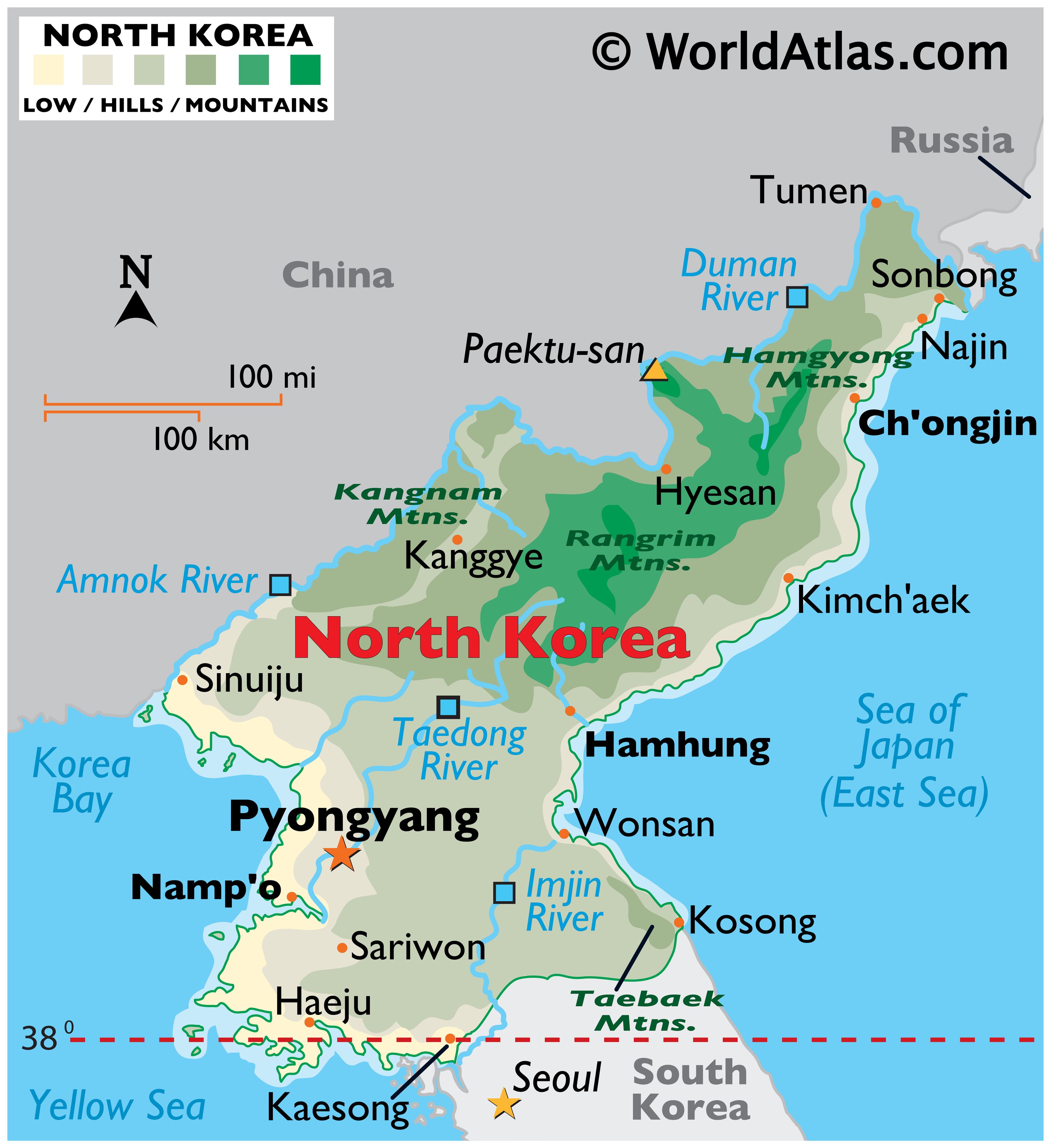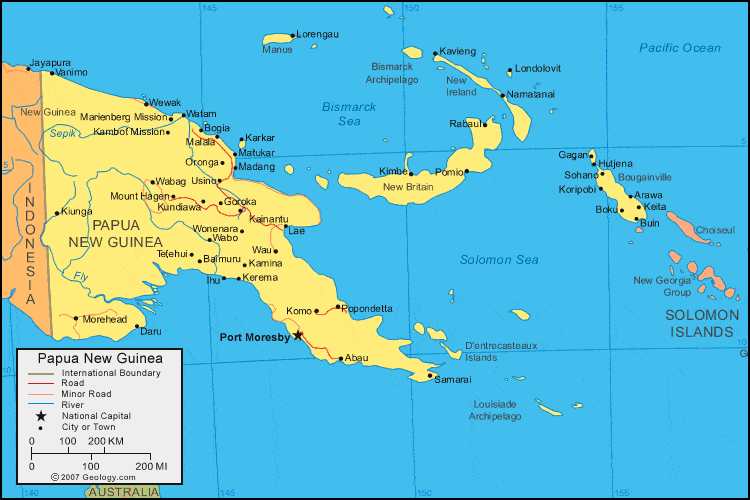Size, North Korea and PNG
The 6 geographical factors derived from various definitions of the term 'geopolitics' is the suggested framework be used to analyze or understand different geopolitical issues in the Asia-Pacific region. The geographical factors are:
- Natural resources - impact of the competition for natural resources on the political behaviour of state and non-state actors.
- Geographical location - impact the geographical location of a state actor has on the political behaviour of another state or non-state actor.
- Size - impact of a state actor on the political behaviour of another state or non-state actor in regards to its physical land area. Size of a non-state actor and its impact on the political behaviour of a state and other non-state actors.
- Topography - impact of either man-made and natural surface features of land on the political behaviour of state and non-state actors.
- Demography - impact of the characteristics of human population on the political behaviour of state and non-state actors.
- Climate - impact of the climate on the political behaviour of state and non-state actors.
Morgenthau classifies geography as a stable element of national power. Under geography he further divides this element into 3 different types; location, size and topography. On the other hand, Organski labels geography as a natural element.
Stable means that one cannot change quickly or easily the size of a particular country. The land area of China in square kilometers is 9, 388, 211. This fact, apart from being stable, is also natural, but it can be altered through the complex process of land reclamation or annexation of new territory.
Thomson and Clinton (2006, p.124), in a revised version of Morgenthau's book titled 'Politics among nations: The Struggle for power and peace' first published in 1948, included a paragraph on size. They said:
The possibility of war has enhanced the importance of the size of a territory as a source of national power. In order to make a nuclear threat credible, a nation requires a territory large enough to disperse its industrial and population centers as well as its nuclear installations. The conjunction between the large radius of nuclear destruction and the relatively small size of their territories imposes a severe handicap upon the ability of the traditional nation-states, such as Great Britain and France, to make a nuclear threat credible. Thus it is the quasi-continental size of their territory that allows nations, such as the United States, the Soviet Union, and China, to play the role of major nuclear powers."
Amad (n.d.) says that size makes possible the support of a large population and the possession of large resources. A large size can be a blessing, not only because it provides strategic depth and strategy options, but also because larger size is expected to contain more natural resources and space for various activities such as agriculture, farming or scientific experiments.
North Korean issue and PNG
On September 2, 2016, North Korea carried out its fifth nuclear test. The Foreign Minister of PNG joined the rest of the international community and condemned the actions of North Korea. He said:
"Pyongyang must heed such unequivocal warning of the international community as it violated all existing United Nations Security Council Resolutions (UNSCR)."
Minister Pato explained that PNG is a signatory to the Comprehensive Nuclear Test Ban Treaty (CTBT). As a signatory, PNG supports the call by South Korea for the entry into force of the Treaty as North Korea's obsession with nuclear testing reminds us that there is a huge price to pay for the long overdue entry of the Treaty. Pato also calls on the international community to urge remaining Annex II states of the CTBT to take the lead in ensuring that the Treaty enters into force.
The Prime Minister of PNG, on 23 September 2017 reiterated at the United Nations General Assembly the same message given by Minister Pato in the Philippines, when he attended the ASEAN regional forum a few weeks earlier. O'Neill said:
"We condemn, in the strongest possible terms, the recent nuclear detonations and missile tests by North Korea. These are direct threats to the lives of millions of innocent people in the United States, Japan, South Korea. In particular we are concerned that these activities are taking place in the Pacific region. This is in direct breach of the will of the international community, as expressed through the numerous resolutions of the Security Council. Rather than inflamed rhetoric that could have drastic consequences, we call for peaceful resolution through political dialogue."
Both leaders talked about the issue at the United Nations General Assembly which is the largest international intergovernmental organization. The Foreign Minister also brought it to the attention of ASEAN member states. This is a clear cut case of PNG engaging in geopolitical issues in the Asia-Pacific region through international and regional multilateral platforms.
But why is PNG worried about North Korea if we refer back to the logic of 'bigger the size, the more credible the threat' advocated by Thomson and Clinton (2006) in Morgenthau's work?
If we look at the geographical factor of size alone we rule out North Korea as a credible threat. North Korea is a small state in size compared to PNG. The land area of North Korea in square kilometers is about 120, 408. It is smaller than PNG which is about 462, 840 square kilometers.
Hypothetical scenario
If North Korea attacks South Korea using one of their nuclear bombs. The attack will cause the United States as an ally of South Korea to react by launching one of its nuclear bombs directly at Pyongyang which has a population of 2, 222, 000.
Furthermore, what if the US nuclear bomb is a 1 megaton bomb, which is 80 times larger than the bomb detonated over Hiroshima. For such a bomb, people up to 21 km away would experience flash blindness on a clear day, and people up to 85 km away would be temporarily blinded on a clear night.
The city of Nampo is the third largest city with a population of about 455,000 and is 57.5 km from Pyongyang. That means on a clear night the population would be temporarily blinded. On the other hand, the second largest city of Hamhung which is about 307.3 km away from Pyongyang with a population of 559, 056 will not be affected.
In regards to heat, mild and first degree burns will occur up to 11 km away. Third degree burns that destroy and blisters the skin tissue will affect those living up to 8 km away. That means both cities will be safe. However, the energy released in the nuclear explosion, radiation poisoning and nuclear fallout are other effects that will affect everyone.
North Korea does not have a quasi-continental size territory like China. Its smallness is a big risk factor. A 1 megaton bomb will annihilate a sizable portion of its population if it is dropped on Pyongyang. In other words, the size factor is a deterrence.
Imagine if a 1 megaton bomb was dropped on Kundiawa which is more or less the center of PNG. The province of Simbu has a population about 376, 473 as per the 2011 census and shares provincial borders with Easter Highlands (579, 825), Jiwaka (343, 987), Gulf (158, 194), Southern Highlands (510, 089) and Madang (493, 906). The effects of the nuclear bomb will affect close to 3 or 4 million people.
Apart from the provinces listed, Western Highlands (362, 850) is close to Jiwaka. All of the highlands provinces together house a huge proportion of the country's population. This strategic fact will certainly feature in the military plans of any future adversaries.
Conclusion
Size matters in geopolitics. A larger country like the US can exert a level of influence on other state and non-state actors in the international system. But the same can be said for countries which are smaller in size like North Korea or PNG.
It is imperative that both leaders make the country's stance on the North Korean issue clear via various multilateral forums in order to mitigate future threats. Their calculated responses is also in adherence to international norms. Such an approach depicts PNG as an active member of the international community regardless of our size.
Reference
Morgenthau, H. J. (2006). Politics among nations: the struggle for power and peace (7th ed.). Boston: McGraw-Hill Higher Education.


Comments
Post a Comment